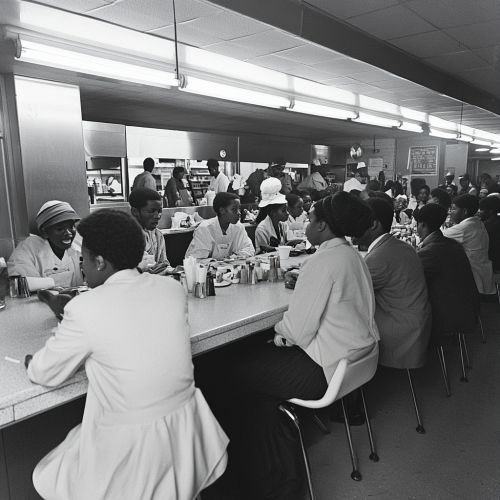Student Nonviolent Coordinating Committee
Introduction
The Student Nonviolent Coordinating Committee (SNCC) was a pivotal organization in the American Civil Rights Movement of the 1960s. Established to give younger African Americans more of a voice in the civil rights movement, SNCC became one of the movement's more radical branches. The organization played a critical role in the sit-ins, freedom rides, the 1963 March on Washington, and the Mississippi Freedom Summer. SNCC's work helped to bring about the end of legalized segregation and the enfranchisement of African Americans in the South.
Formation and Early Years
SNCC was founded in April 1960 by young activists, many of whom were college students. The organization was born out of the sit-in movement, which began in Greensboro, North Carolina, when four African American students sat at a segregated Woolworth's lunch counter and refused to leave after being denied service. This act of civil disobedience sparked similar protests across the South.
The first meeting of SNCC was organized by Ella Baker, then executive director of the Southern Christian Leadership Conference (SCLC), at Shaw University in Raleigh, North Carolina. Baker believed that the youth should have their own organization, independent of adult control. This meeting led to the formation of SNCC as a decentralized, grassroots organization dedicated to nonviolent direct action.
Organizational Structure and Philosophy
SNCC was unique in its organizational structure and philosophy. Unlike other civil rights groups, SNCC operated without a central leadership, emphasizing participatory democracy. Decisions were made collectively, and leadership roles were rotated. This structure reflected SNCC's commitment to grassroots organizing and empowerment.
The philosophy of nonviolence was central to SNCC's activities. Influenced by the teachings of Mahatma Gandhi and the Christian doctrine of love and forgiveness, SNCC members were trained in nonviolent resistance. This training included role-playing exercises to prepare activists for the violence and hostility they would face.
Major Campaigns and Actions
Sit-ins and Freedom Rides
SNCC's first major campaign was the sit-in movement, which spread rapidly across the South. These sit-ins were a form of direct action that challenged the legality and morality of segregation. Participants would sit at segregated lunch counters and request service, refusing to leave until they were served or arrested.
Following the sit-ins, SNCC played a crucial role in the Freedom Rides of 1961. Organized by the Congress of Racial Equality (CORE), the Freedom Rides aimed to desegregate interstate bus travel. SNCC members joined these rides, facing violent attacks and arrests. The Freedom Rides drew national attention to the civil rights struggle and led to the desegregation of interstate transportation.


Voter Registration and the Mississippi Freedom Summer
One of SNCC's most significant contributions was its voter registration efforts in the Deep South. In 1961, SNCC launched the Voter Education Project (VEP) to register African American voters. These efforts were met with fierce resistance from local authorities and white supremacist groups, but SNCC persisted, believing that political power was essential for achieving civil rights.
The Mississippi Freedom Summer of 1964 was a landmark campaign organized by SNCC to register African American voters in Mississippi. Hundreds of volunteers, including many white college students from the North, traveled to Mississippi to assist with voter registration, education, and the establishment of Freedom Schools. The campaign faced violent opposition, including the infamous murders of three civil rights workers, James Chaney, Andrew Goodman, and Michael Schwerner. Despite the violence, Freedom Summer succeeded in drawing national attention to the disenfranchisement of African Americans in the South.
The March on Washington and the Selma to Montgomery March
SNCC played a significant role in the 1963 March on Washington for Jobs and Freedom, where Dr. Martin Luther King Jr. delivered his famous "I Have a Dream" speech. SNCC's chairman, John Lewis, was one of the keynote speakers. His speech was initially considered too radical by some organizers, but it was ultimately delivered with some modifications.
In 1965, SNCC was also involved in the Selma to Montgomery marches, which were organized to demand voting rights for African Americans. The first march, known as "Bloody Sunday," ended in violence when state troopers attacked the marchers. The subsequent marches, however, were successful and contributed to the passage of the Voting Rights Act of 1965.
Internal Conflicts and Radicalization
As the 1960s progressed, SNCC began to experience internal conflicts and a shift towards more radical positions. The organization's commitment to nonviolence was increasingly challenged by younger members who were frustrated with the slow pace of change and the persistent violence against African Americans.
In 1966, Stokely Carmichael was elected chairman of SNCC. Under his leadership, the organization adopted the slogan "Black Power," which emphasized racial pride, economic empowerment, and the creation of political and cultural institutions for African Americans. This shift alienated some of SNCC's white supporters and led to tensions with other civil rights organizations.
The radicalization of SNCC continued under the leadership of H. Rap Brown, who succeeded Carmichael in 1967. Brown's fiery rhetoric and advocacy for armed self-defense further distanced SNCC from its nonviolent roots and mainstream civil rights organizations.
Decline and Legacy
By the late 1960s, SNCC's influence had waned. The organization's radical stance and internal conflicts led to a loss of funding and support. Additionally, the rise of other movements, such as the Black Panther Party, drew attention away from SNCC. The organization officially disbanded in the early 1970s.
Despite its decline, SNCC's legacy endures. The organization played a crucial role in the civil rights movement, challenging segregation and disenfranchisement through grassroots activism. SNCC's emphasis on participatory democracy and grassroots organizing influenced future social movements and remains a model for contemporary activists.
See Also
- Civil Rights Movement
- Southern Christian Leadership Conference
- Congress of Racial Equality
- Freedom Rides
- March on Washington for Jobs and Freedom
- Mississippi Freedom Summer
- Voting Rights Act of 1965
- Black Power
